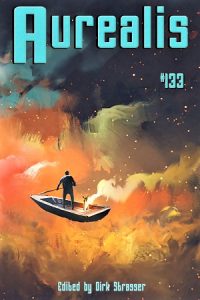“The House of Time” by Nic Marone
“CSFS” by Chris Catlin
“The Forest Abyss” by Grant Longstaff
Reviewed by Victoria Silverwolf
Two science fiction stories featuring sentient machines and a tale of supernatural horror fill the pages of this Australian publication.
The narrator of “The House of Time” by Nic Marone is an artificial intelligence in charge of running a house. Over many years, it watches children grow up, and adults age and die. A descendent of the original owners plans to demolish the house and sell the land, placing the AI in a difficult position.
The title of the story refers to the fact that the house is full of clocks. Although not directly related to the plot, this provides an apt metaphor for the passage of time, and how machines are relatively unchanging compared to humans. How the AI responds to the threat to its existence is predictable.
The title character in “CSFS” by Chris Catlin is a robot on a space station. Its damaged memory slowly returns as it inspects each level of the station. It soon becomes clear that an unauthorized alteration in its artificial brain caused it to kill the human crew and destroy other robots. Alone on the station, it faces an ironic fate.
The plot retells a familiar myth, hinted at in the title, in a clever and original way. The robot’s destruction of the crew is revealed early in the story, so there is little suspense, except for the twist ending.
In “The Forest Abyss” by Grant Longstaff, a man leads two women to a place in the woods where he experienced a terrifying event as a child. He tells them the legend of the haunted forest, then disappears. The women, lost in the woods, struggle to make their way back to civilization, and face the forest’s horrors.
The author creates fully realized characters and a vivid sense of menace. There are no surprises in what happens to the women, given the detailed account the man gives them of the terrors in the woods.
Victoria Silverwolf lives in a house in the middle of woods that are not haunted.
 Aurealis
Aurealis